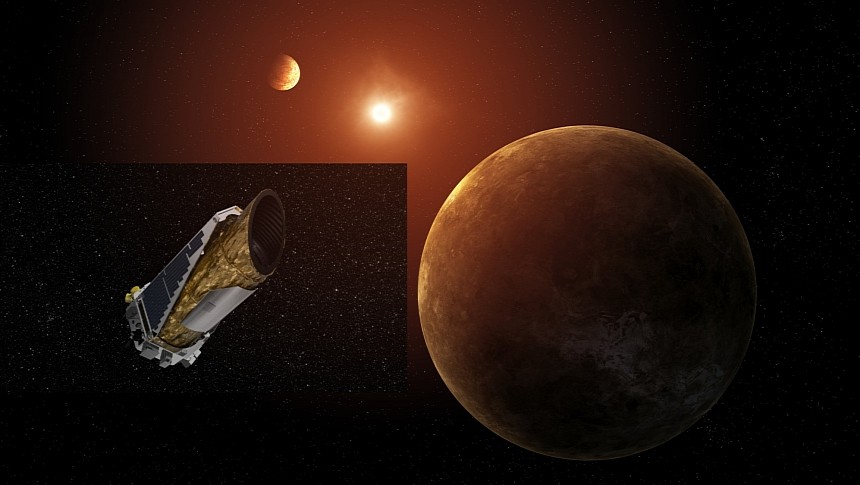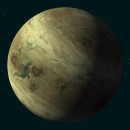When we think of exoplanet systems outside of our neck of the cosmic woods, we tend to imagine them appearing much like our own Solar System. One with a handful of dense, rocky spheroids occupying the inner space with a load of frozen gas giants orbiting around the outer circumference. All while the host star bathes the area in just enough heat and light to sustain life on at least one planet, if not more. Well, an exoplanet cluster recently discovered by NASA is anything but hospitable.
Say hello to the Kepler 385 system. It has more in common with the modern conception of hell than any resemblance to our own cosmic neighborhood. Thanks to data collected from the now-defunct Kepler Space Telescope, we have an idea of the horrors beyond human comprehension that lurk 4,670 light-years away from our cozy nook of the galaxy. Comprised of at least seven exoplanets ranging in size from slightly bigger than Earth but a touch smaller than Neptune, each heavenly body in this system bears the brunt of its home star's endless wrath.
Though it's only around ten percent larger and burns five percent hotter than our own Sun, the influence this star imposes on its planetary children dwarfs that of our mother star. As newly deciphered data from the Kepler Telescope indicates, each planet in the Kepler 385 system is continuously bathed in torrents of thermal radiation flung off from fusion reactions deep within its home star's nuclear core. What this means for the planets within the star's orbit can only be described as making the average day on Venus look like a vibrant spring day here on Earth.
The colossal forces hurled at the ostensibly rocky inner planets in this system have suppressed their atmospheres to the point they're comparatively paper thin. Meanwhile, the outer gas giants, too small to undergo solar fusion a la Jupiter, still retain their thick atmospheres and likely a variable treasure trove of Jovian-like moon systems around each of them.
Thanks to recent interpretations of data gathered from the Kepler Telescope since its retirement in 2018, scientists now have a more holistic understanding of how the same building blocks that formed our own Solar System can result in a place so thoroughly alien. With the benefits of a comprehensive list of over 700 exoplanet systems and 4,400 planet candidates, databasing the Kepler Telescope's latest finding was easier than ever.
"We’ve assembled the most accurate list of Kepler planet candidates and their properties to date,” said Jack Lissauer, a research scientist at NASA’s Ames Research Center in California’s Silicon Valley and lead author on the paper presenting the new catalog. “NASA’s Kepler mission has discovered the majority of known exoplanets, and this new catalog will enable astronomers to learn more about their characteristics." By all measures, Kepler could be revealing clues about our universe from beyond the grave for many years to come.
Though it's only around ten percent larger and burns five percent hotter than our own Sun, the influence this star imposes on its planetary children dwarfs that of our mother star. As newly deciphered data from the Kepler Telescope indicates, each planet in the Kepler 385 system is continuously bathed in torrents of thermal radiation flung off from fusion reactions deep within its home star's nuclear core. What this means for the planets within the star's orbit can only be described as making the average day on Venus look like a vibrant spring day here on Earth.
The colossal forces hurled at the ostensibly rocky inner planets in this system have suppressed their atmospheres to the point they're comparatively paper thin. Meanwhile, the outer gas giants, too small to undergo solar fusion a la Jupiter, still retain their thick atmospheres and likely a variable treasure trove of Jovian-like moon systems around each of them.
Thanks to recent interpretations of data gathered from the Kepler Telescope since its retirement in 2018, scientists now have a more holistic understanding of how the same building blocks that formed our own Solar System can result in a place so thoroughly alien. With the benefits of a comprehensive list of over 700 exoplanet systems and 4,400 planet candidates, databasing the Kepler Telescope's latest finding was easier than ever.
"We’ve assembled the most accurate list of Kepler planet candidates and their properties to date,” said Jack Lissauer, a research scientist at NASA’s Ames Research Center in California’s Silicon Valley and lead author on the paper presenting the new catalog. “NASA’s Kepler mission has discovered the majority of known exoplanets, and this new catalog will enable astronomers to learn more about their characteristics." By all measures, Kepler could be revealing clues about our universe from beyond the grave for many years to come.





